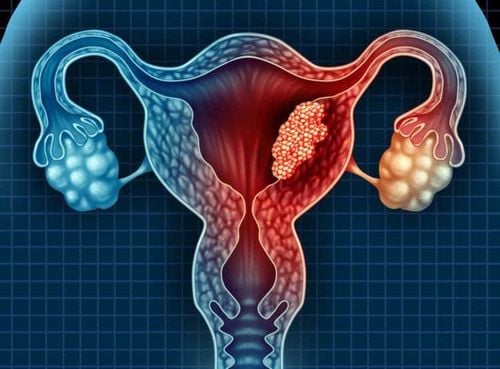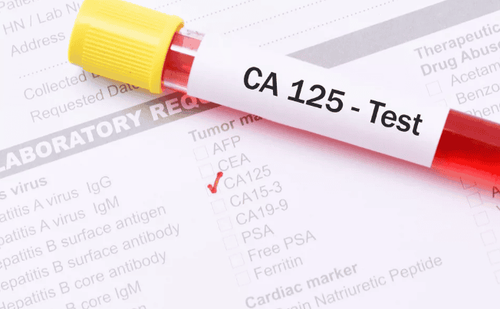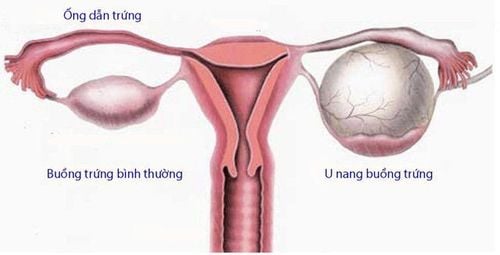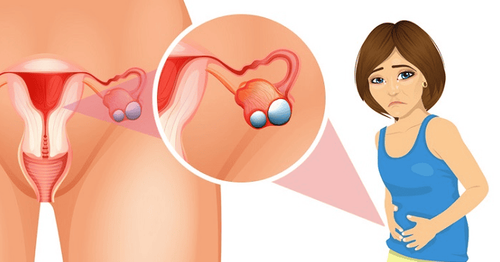This is an automatically translated article.
The article was professionally consulted by Specialist Doctor I Tran Thi Phuong Loan - Obstetrician and Gynecologist - Department of Obstetrics and Gynecology - Vinmec Phu Quoc International General HospitalOvarian cysts account for about 80% of ovarian tumors, a small percentage of which can lead to dangerous complications. Only the early detection and diagnosis of the disease can help the patient to be cured in the safest and most economical way.
1. Types of ovarian cysts
Functional cysts: These are tumors arising from endocrine disorders of the ovary, anatomically, the ovarian organization has not changed. Ovarian follicles (ripe follicles do not burst, do not ovulate). This cyst continues to grow (possibly > 10cm, potentially bursting and causing bleeding), continues to secrete oestrogen, causing the patient to delay menstruation.
Thyroid cyst: common in patients with trophoblastic cancer, multiple pregnancies, and infertility treatment patients.
Organic cysts: These are true tumors with changes in ovarian histology, so these are tumors with a high risk of cancer. On the tumor surface, there are comb-shaped proliferative blood vessels, or papillae on the surface or inside the tumor are signs of cancer. Mucinous cysts account for about 20% of ovarian tumors, often large, up to several tens of kilograms, often attached to surrounding tissues. Dermoid cysts account for about 25%, often teratomas, the tumor organization is very special, the tumor wall has a structure similar to skin, sebaceous glands... inside the cyst usually contains hair, teeth,...
Peanuts Endometrial cyst: Endometrial tissue is an organization that grows right on the surface of the ovary, which can cause damage to healthy ovarian tissue. Cysts are usually small, thin shell, stick to surrounding tissues, inside are filled with brown fluid, often painful, stick to fallopian tubes and cause infertility.

U nang buồng trứng có nhiều dạ
2. Diagnosis of ovarian cysts
The disease diagnosis process always has a combination of clinical and subclinical to achieve high accuracy.
2.1 Clinical diagnosis Diagnosis of patients is based on disease symptoms including:
Menstrual disorders. Pain or discomfort in the pelvic area. Decreased sexual ability Body weakness due to complications of bowel obstruction or urinary retention or complications such as torsion, rupture of cysts. The mammary glands develop, pubic hair appears, and the sex organs develop despite the lack of ovulation. in girls with precocious puberty 2.2 Subclinical diagnosis Ultrasound: Ultrasound is a diagnostic tool in most diseases of the genital organs. Transabdominal ultrasound is often suggested, in many cases to increase accuracy the doctor may order a transvaginal ultrasound.
MRI or CT scan: An MRI can show more clearly the results of an ultrasound, while a CT scan helps diagnose the spread of the cyst.
Aspiration cytology: helps in differential diagnosis of benign and malignant tumors.
CA-125 serological test: Blood test for CA-125 antigen (CA: Cancer Antigen) which is associated with ovarian cancer. This test is used in the evaluation of ovarian carcinoma and helps determine whether the tumor is benign or malignant. However, some other diseases such as uterine fibroids or endometriosis also test positive for CA-125. Therefore, this test has no diagnostic value in deciding whether a patient has ovarian cancer or not.
Hormone levels: Blood tests to check levels of LH, FSH, estradiol, and testosterone help check the levels of these hormones in the body.
Pregnancy test: Treatment of ovarian cysts in a pregnant and non-pregnant patient is completely different. Another reason is that ectopic pregnancy can be missed because the symptoms are quite similar to ovarian cysts.
Douglas cystoscopy: To collect a sample of fluid from the pelvis with a needle inserted through the vaginal wall behind the cervix.

Xét nghiệm huyết thanh CA-125 tìm kháng nguyên CA-125
3. Possible complications if not diagnosed early
Torsion of the cyst: Can occur with any type of tumor. Small, pedunculated, non-adhesive tumors are susceptible to torsion. When torsion tumor, the patient presents with severe abdominal pain, possibly nausea, vomiting, sometimes shock because of pain, abdominal distension, pain in the lower abdomen and 2 pelvic fossa, with abdominal wall reaction. Vaginal examination shows that the tumor is very tight, less mobile, and the patient feels a sharp pain when pressed.
Ruptured cyst: Patients often present with sudden, continuous abdominal pain, lower abdomen and 2 painful, reactive pelvic fossa. In the majority of cases, rupture of the cyst causes bleeding, which can cause shock and loss of blood to the patient. Vaginal examination revealed a hard-to-define tumor, painful uterine mobility. After rupture of the cyst, the patient often has an infection syndrome, abdominal distention, may have peritoneal tenderness, vaginal examination shows a sticky tumor, little mobility, tenderness.
Compression of surrounding organs: This complication is often late, when the tumor has grown to a large size. Tumor compresses the bladder causing urination, compresses the rectum causes constipation. Sometimes the tumor can compress the ureter causing pyelonephritis, compress the inferior vena cava causing collateral circulation, edema of the lower extremities, and ascites.
4. When to have ovarian cyst surgery?
For functional cysts that usually do not need treatment, they disappear on their own after a few menstrual cycles. Administer combined oral contraceptives to patients with functional cysts with unproven efficacy. Functional cysts also have complications such as cyst torsion, rupture of the cyst with bleeding, requiring emergency surgery, but are rare.
On the contrary, when detected organic cysts need to be operated as soon as possible to avoid complications. Depending on the size and nature of the tumor and the patient's desire to have children, you can choose a radical surgical method to remove the entire tumor and the affected ovary or just remove the tumor to leave the healthy ovary. Although tumor ablation may increase the risk of ovarian cyst recurrence.
Surgical methods include:
Laparoscopic surgery: in this method, the surgeon will make an incision in the surgical site to insert the catheter into the abdomen. The cystoscope locates the cyst and can remove the cyst or take a sample for a biopsy.
Open surgery : This is invasive surgery by making an incision through the abdominal wall to remove the cyst. Patients undergoing this type of surgery may have a longer recovery time.
When there are signs of ovarian cysts, you should go to reputable medical facilities to be examined by an obstetrician and gynecologist and accurately diagnose ovarian cysts, thereby taking timely treatment measures. .
Please dial HOTLINE for more information or register for an appointment HERE. Download MyVinmec app to make appointments faster and to manage your bookings easily.













